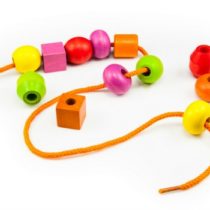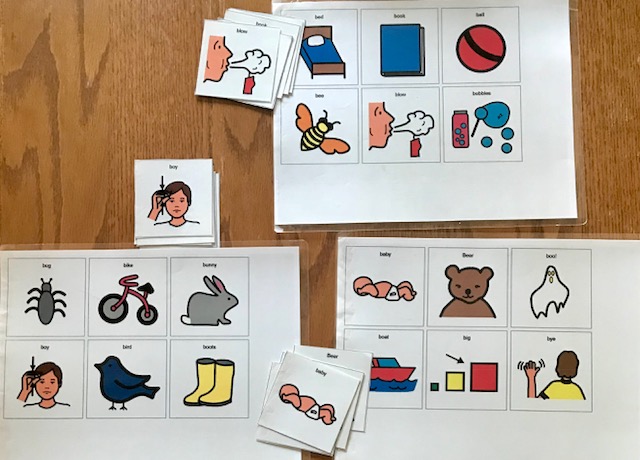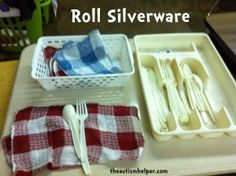Blog #215 DS-ASD Independent Work Activity Ideas
Task bins and binders are a great way to teach academic, vocational and independent living skills. The sky is the limit when creating activities to develop fine motor skills, letter, number and object recognition, sorting, assembly and sequencing. My son Nick is 24 years old and has a dual diagnosis of Down syndrome and autism (DS-ASD). I’ve created many TEEACH (Treatment and Education of Autistic and Communication Handicapped Children) inspired activities for my son. The TEEACH method is a structured learning environment that is visual based to help cue a student to working independently.
When introducing task bins and binders, begin with one or two at a time. Create a visual schedule that you can build upon that includes something to work for (a highly preferred reward).
First-Then Visual:

Once your child or student is successful with the First-Then schedule, begin to increase the time on task and introduce new task bins and binder activities.
Expanded Work Schedule:

So, what type of work activities should you include for your child or student? My first suggestion is to look at their strengths and build around those. My son, Nick is good at sorting and sequencing. Over the years in his IEP’s (Individual Education Plan), we have built goals and jobs around this strength. Secondly, pick activities that the child or student can do with success and minimal prompts. This will help them stay motivated and be less frustrated. Finally, once skills are mastered independently, begin to add in new tasks one at a time. The new tasks should always be paired with the mastered skills, to encourage confidence and minimize frustration. Note that point prompting and hand-over-hand may be necessary to assist them in the new task.
Examples of Fine Motor Skill Development Activities:




Puzzles and Matching games can foster academic and speech development:
Be sure to include puzzles and activities that your child or student enjoys, whether it’s Thomas the Tank Engine or Disney’s movie Frozen; this will peak their interest in working. 🙂
These binder activities were made by a speech therapist, grouping like sounds together to work on articulation in addition to matching:

Color matching binder activity:

Teaching matching and pairing them with holidays and season changes binder activities:


Teaching emotions matching binder activity:
(Does the child or student respond and understand better to actual photos or icons? Build the activities around what works best for them)

![]()
Assembling and sequencing activities can build skill development for future vocational work:




Silverware sorting and rolling could lead to a job in a resturaunt:


Currently, my son Nick is working for 30-45 minutes on task bins and binders. Here’s how I’ve set it up at home:




Depending on how he is feeling, I gauge what to put in each work bin. On this particular day, he was not moving as swiftly through the tasks; so I only put one in each bin. However, there are other times when he flies through the work, so I’ll put in a several in each bin. Bottom line, listen to your child or student, and look for cues if they seem tired or frustrated and ease off on the demands you are placing on them.
School support teachers/case managers, speech, occupational and ABA therapists are great resources to ask for ideas and materials. There are plenty ideas on Pinterest. Many of the materials can be bought at dollar or Five Below stores as well as garage sales and resale shops.
Task bins and binders help children, students and adults like my son, Nick to develop academic, vocational and independent living skills. Be consistent in the delivery with visuals, task and rewards, introducing the work in small increments. Alternate the activities with easier or personal interests, (EX/ Disney’s Frozen or Thomas the Tank engine puzzles and matching). New activities and skills may require hand-over-hand assistance and point prompting. If the child or student becomes distracted, or bored remind them what they are working for by pointing to the reward (which has been pre-selected). During the work session, listen to signs and cues of distress or frustration. Offer encouragement (good job, you got it, yay, uh oh-try again) and back off on the amount of work and time spent before behavior escalates to anger. Choose activities that promote academic, future employment (whether it’s paid or volunteer work), and functional living skills.
Task bins and binder activities done both at home and school, will help your child or student become confident, more independent and productive in society. That’s what is in my noggin this week. 🙂
~Teresa
Follow Nick on Social Media and view videos of Big Guy in action:
Facebook and Pinterest @Down Syndrome With A Slice Of Autism
Instagram @nickdsautism
Twitter @tjunnerstall


















